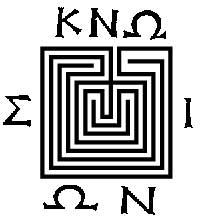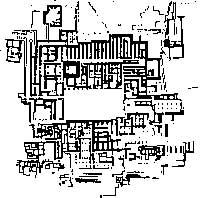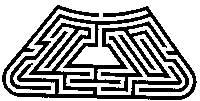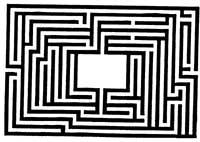Labyrinths
Just read the word Labyrinth, the story of the labyrinth of Crete comes to mind. This story tells us that once Queen Pasifae fell in love with a white bull. In order to get closer to him, he ordered Dédalo to build a cow cow cow. With that trick he was able to approach the bull and (we do not know how, because as we always hide the part of the stories) that relationship arose Minotaur. Surprised and ashamed, King Minos ordered Daedalus to hide Minotaur. Dédalo built a large labyrinth into which Minotaur entered. History does not end there, but our theme is not the life of Minotaur, but the labyrinth.

Bronze and silver coins remained of this history, although the Greeks belonged to the island. To one side you can see the face of a Minotaur or god. On the other side there is a labyrinth.
However, Crete is not the first known labyrinth. In fact, the Greek historian Herodotus speaks of an Egyptian labyrinth, two estayas and a huge extension. The same herodote was in the superior and only the initiates could enter the lower.
Over the centuries the labyrinths were forgotten until in the Middle Ages the slab of the cathedrals became a path. Sometimes the images are repeated on the walls. At the same time they are given new names, such as meander, davits, way to Jerusalem,... The latter was considered a substitute for the royal roads to the Crusades. In England they were built with fences and green fences. At Hampton Court there is a maze still visible. Also built in stone in Scandinavia.
XX. In the 20th century they have appeared in different media. Scientists analyze the behavior of animals in the labyrinth. A school of psychology has been created in the USA, whose postulates have been applied in the Vietnam War. Other scientists investigate the march of an automaton. When the automaton reaches a canton, it always turns to the same face. Before late, you will be able to go down the shortest road anywhere. If the automaton opts for random spin, we would not know if it would be right or not. He is conducting the first artificial intelligence sessions.

Now we know that it can be programmed to get many machines into the labyrinth, but what did Theseus do to find Minotaur? Ariadna's thread ensured her return. Not so the road to Minotauror. Plutarko, the most complete source, says that Ariadna taught him the way, but does not say how. But archaeology gives us another interpretation. Sir Arthur Evans discovered the ancient capital of Crete, Knosos, the former royal palace. On the walls you could see the image of the coin and bullfighting figures. In some places there was a double axe called labrys. Labyrinth, therefore, would be the place of the labrys. Minos was the general name of the governor (such as Caesar or Tsar) and the minotaurs the bulls of the king. Therefore, Minotaur and his dwelling were at the head of the palace visitors, for the surprise that caused them the grandeur of the palace. He was the builder of the Daedalus palace (Figure 2).

Of course, if there was no labyrinth, no instructions were needed. In the image of the coin nobody can get lost because the road is unique. The real labyrinths were not until the end of the Middle Ages. Hampton Court and Hatfield House need a plane or directions to get to the center. The ideal would be the algorithm or clarifications that can be used in all cases, since the plane of a labyrinth does not serve for another.
Between the labyrinths two types should be differentiated: those that have closed paths, that is, the labyrinths with a piece of barrier separated from the rest (of multiple union) and the others (of simple union). The instructions for walking in the simple bonding maze are simple. Put your hand on a wall and start walking without removing it. This method ensures entry and exit even if it is not the shortest path.

To move through multi-link mazes requires another algorithm. This algorithm was issued last century by Mr. Tremaux. Grab the pencil and start drawing without removing the wall as before. As before, you have to turn in the closed paths by a wall that is not scratched. At some junction you will see the path drawn. Back down the unscratched wall. If there are no such walls, take another path with a line. Never access roads with both walls. If when you get to the center you stop drawing, at the exit you will be led roads with a single line.

The aforementioned labyrinths, except that of Egypt, are two-dimensional, that is, they are located on a plane. The third dimension is obtained by overlapping several labyrinths of the same plant and joining the corresponding moments. Another option is that the paths that go from top to bottom and from bottom to top also form labyrinths. However, the same algorithm given in all cases serves to enter and exit.





